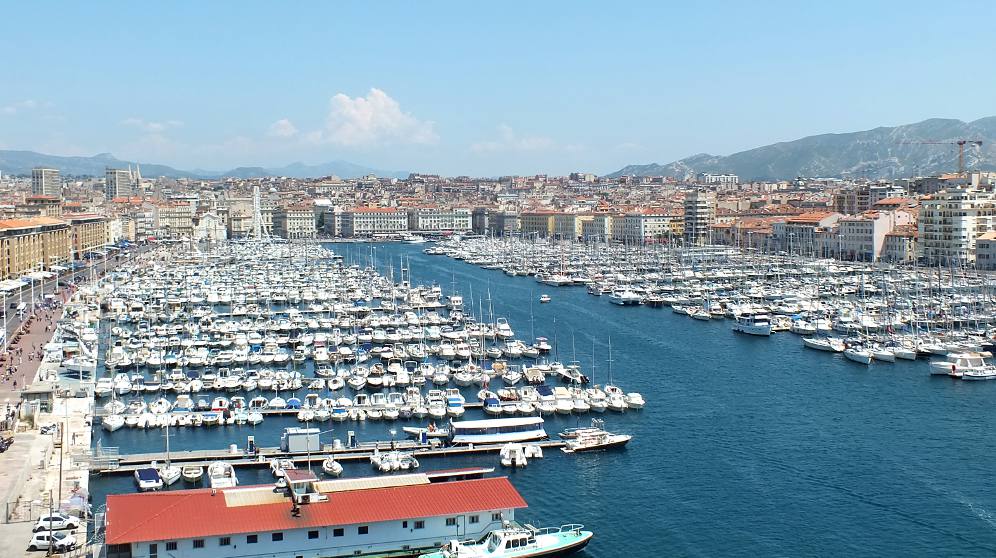- Explore France ►
- Essential pages
- Travel in France
- Where to go
- What to see and do
About-France.com
- the connoisseur's guide to France
Marseille - city visitor and tourism information
| On this page | Location and access | Tourist attractions |
| In the area | Hotels in Marseilles |
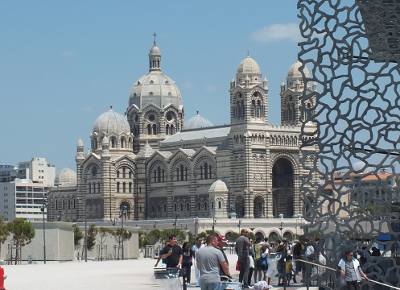 La
Major cathedral, from the entrance to the Mucem museum.
La
Major cathedral, from the entrance to the Mucem museum.Marseille is the "oldest city in France" and indeed one of the oldest in western Europe. The city was founded as Massalia in around 600 BC, and soon developed into an important port in the ancient Greek world. For the Greeks, and later for the Romans, it was a major point of transition and trade between the civilisations of the Mediterranean, and those of Gaul and northwest Europe.
And that, essentially, has been Marseilles' role ever since. Located near the mouth of the Rhone - the greatest natural corridor between the Mediterranean and the lands to the north, it has long been one of the most important, when not the most important, port in France – a role that explains its importance and its size, as France's third largest urban area, to this day.
Rather in the same way as Genoa or Naples, Marseilles' importance as a port rather hindered its development as a tourist destination; and while other Mediterranean ports like Barcelona and Valencia began to develop their tourism in the 1970's, Marseilles did not. Its port was too important. But more recently, Marseilles has managed maintain its status as one of the most important ports on the Mediterranean, and develop as a tourist destination at the same time.
Provence EscalettoFort
Saint Jean from the top of King René's tower.
The paradox with Marseille is that although it stands proudly
beside the Mediterranean, it is not a seaside resort. The gentler and
flatter coast northwest of the city is occupied by the docks,
and
southwards from the "Old Port", the seashore is rocky, with no beaches
until the Plage du Prado, 6 km further south. So it's not a
place
to visit if the aim of the trip is solely or mainly to enjoy the beach.
The shoreline and the waterside ambiance, yes; but the beach, no.For a day-trip or a weekend break or short stay, Marseilles is an ideal destination, specially during those times of the year when it tends to be bathed in Mediterranean sunshine while much of France further north is still struggling with spring or dampened by autumn mists and showers. And getting to the tourist quarter of Marseille around the Old Port is remarkably easy.
Access to Old Marseilles
The Old Port, though the tourist centre of the city, is directly accessible from the north and west, and from the east, by motorway. Indeed the motorway runs through a tunnel right under the Old Port. From the north, enter Marseilles on the A55 motorway (not the A7) and take exit 2 just before the tunnel – marked Centre ville. From the east, enter Marseilles on the A50 motorway, following signs for the town centre and ports. Take the Prado-Carénage tunnel, which becomes the Tunnel du Vieux Port. Exit immediately after the Tunnel du Vieux Port, where you emerge right opposite the cathedral. There are large paying car parks and street-parking in the vicinity.For visitors arriving by train, it is less than a kilometre's walk down from the Gare Saint Charles station to the Old Port.
The area around the Old Port is the tourism heart of Marseilles, and very attractive too now that the 1970s motorway that formerly stood on stilts between the town and the shore has been put down into a tunnel.
The most interesting and attractive sites of Marseilles can all be reached on foot from a starting point at the Mucem, the Museum of European and Mediterranean Civilisations.
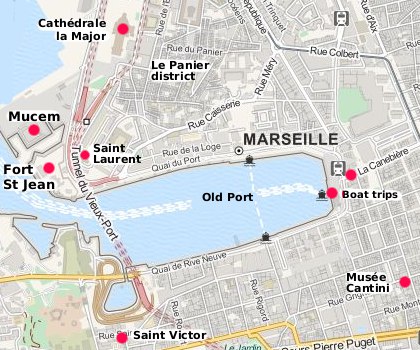 Central
Marseilles, around the Old Port.
Central
Marseilles, around the Old Port.Le Vieux Port - the old port
The tourism mecca of Marseilles, the Old Port, the main port of Marseilles for over two thousand years, is now a large marina, flanked on three sides by restaurants bistros cafés and shops. At the inner end of the basin is the pleasure cruise terminal, from which visitors can take boat trips round the port, out to the Island of If, or along the coast to Cassis. for visitors staying more than a day in Marseilles, a boat trip is a must, to experience the views of Marseille from the sea, and the dramatic coastline to the southeast.Sometimes there is a free ferry that operates across the Old Port, close to the entrance. In recent years, services have been sporadic, and there is talk about introducing a charge.
A short way to the south of the Old Port is the Abbaye St Victor, the current building dating from the 12th century church. The crypt contains a collection of sarcophagi tombstones and decoration dating from the 5th to the 12th centuries.
Marseilles Open Tour - hop-on hop-off tour bus
Visit the sights of Marseilles with a Marseilles Open-tour hop-on hop-off bus. More info and tickets from Tourist office. Departs Vieux Port. Circuit includes the sea front, Fort St. Nicolas, Notre Dame de la Garde and the Cathedral. 14 stops in all. One day ticket 27€, 2-days for 37 €The Mucem
- the Museum of the Mediterranean is a modern cultural and historical museum devoted to the civilisations and culture of the Mediterranean. Tickets (2020) 11 Euros - or 18 € for a family ticket. An aerial walkway connects the Mucem to the Fort Saint Jean on the other side of the wharf. Get tickets online.The Fort Saint Jean.
This is perhaps the most impressive historic site in Marseilles - a seventeenth-century fortress, built by King Louis XIV, that stands guard over the entrance to the Old Port. Included in the Fort Saint Jean are the 15th century Tour du Roi René (King René's tower), and the Commandery of the Knights Templar.Access to the Fort Saint Jean is free of charge; there is a charge only for access to special displays which are part of the Mucem, and included in the price of the Mucem ticket. Among the free attractions of the Fort Saint Jean are the fine views over the old city, the old port and the sea, a Mediterranean botanical garden, and the freedom to wander round the ramparts and into some of the historic buildings, including the Tour du Roi René. The upper terraces of the Fort Saint Jean are connected by aerial walkways to the Mucem and to the Old City
The Eglise Saint Laurent
Accessible by an impressive aerial walkway from the Fort Saint Jean, this is one of the older churches in Marseilles, a 12th - 13th century church built in the Provençal romanesque style. It is simple and sobre, in marked contrast to the exuberance of the 19th century Sainte Marie Majeure cathedral (la Major) a few hundred metres to the north. From St. Laurent, it is an easy walk to the old town or to the cathedral or to the Old Port.La Major cathedral
Like the Sacré Coeur de Montmartre in Paris, the La Major cathedral is a fine example of French 19th century neo-romano-byzantine architecture, a sumptuous place of worship making fine decorative use of white marble and red and green stone. In architectural terms, it is a pastiche, incorporating elements of style from different historical periods and styles - towers and cupolas, decorative stonework and mosaics. It is the only cathedral in France built in the nineteenth century.Le Quartier du Panier - la Butte
The St. Laurent church stands at the southeast top of "la butte", the hilly outcrop north of the Old Port. This is the oldest part of Marseilles, an area occupied for over two and a half thousand years. The old quarter here is known as the Quartier du Panier - a network of narrow streets with small shops and restaurants and street vendors. It is hardly 600 metres from end to end. Not to be missed in the quartier du Panier is La Vieille Charité, a former 17th century hospice, with colonnaded facades round a central courtyard. The complex contains several museums, including an archaeological museum and a museum of Africa. Entry to the site is free, but there is a charge for the museums and galleries.La Canebière
The "Champs Elysées" of Marseilles, La Canebière is an avenue running northwest from the end of the Old Port. The Marseilles tourist office is on the Cannebière, just up from the port.Le Musée Cantini
The best fine art museum in Marseilles is located in Rue Grignan, 400 metres southeast of the inner (eastern) end of the Old Port. The Cantini museum specialises in art of the first half and middle of the twentieth century, covering Pointillism, Fauvism, Cubism, Dada, abstract art, and Surrealism – and is one of the best in France for this period. There are plenty of major works by the most important artists of the period, including Matisse, Signac, Dufy, Marquet, Kandinsky, Kokoschka, Miró, Max Ernst, Arp, Picasso, Giacometti, Bacon and many many more. Entrance 5 €uros (2018).Other sites
In addition to a self-guided walking tour in and around the area of the Old Port, as detailed above, there are a number of other places further afield in Marseilles that merit a visit.Notre Dame de la Garde
Another 19th century neo-byzantine church, N-D de la Garde is unmissable, as it can be seen from all over Marseilles. It stands at the highest point in the city, about 160 metres above sea level, to the south of the Old Port. Its domes and cupolas are abundantly decorated on the inside with gilt mosaics. The building uses a similar blend of white and coloured marble to that used in the building of La Major cathedral. It is another fine example of exuberant 19th century architecture. Most of the visitors who go up to the church do so to admire the spectacular views that it offers over Marseilles, the coast, and the surrounding landscape. It can be reached by taking bus line 60 form the old port. A visit to Notre Dame de la Garde is included in one of the "little tourist train" circuits. See belowThe Chateau d'If
A must for the tourist in Marseilles. Boat trips to this island in Marseilles bay depart from the Old Port. The château is a fortress built in the 16th century by François I, which featured in the famous novel by Provençal writer Alexandre Dumas, the Count of Monte Cristo. It was also used in the movie the French Connection. Explore the old prison and enjoy the views of Marseilles from the sea.Musée des Beaux Arts - Fine art museum
Not one of the great French privincial museums, the Marseille fine arts museum has mostly paintings by French artists, though few works by the great masters. It also includes four paintings by Rubens, one by Tintoretto and one by Perugino.Plages du Prado

Rocky shorline, looking towards the Plages du Prado and the hills of the Calanques National Park beyond.
The Little Train
And of course Marseilles has its "petits trains touristiques". Three circuits possible, departing from the north side of the Old Port. 174 Quai du Port, about in the middle of the quay.Madragues de Montredon
A small harbour at the southern end of Marseilles, and the start of the Calanques national park. (See below). Take bus 19 from Rond Point du Prado station on Metro 2 line as far as the terminus at Madrague Mont Rose. Easy access from here to the harbour, then to trails / small roads along the rocky coast to Callelongue. Great views and opportunities for swimming off the rocks..Marseilles' hinterland, Provence, is more popular as a tourist area than Marseilles itself. There are plenty of opportunities for day trips out from Marseilles, some accessible for visitors who do not have a vehicle.
Les Calanques
 Yachts
moored in a calanque at Cassis.
Yachts
moored in a calanque at Cassis.The hills behind the coast are arid limestone. Hikers can access trails from the southern terminus of bus line 22 at "Les Baumettes" (recommended). Connect to bus line 22 from Metro 2 or Bus 83 lines at Rond Point du Prado.
They can also be reached from the terminus of Bus line 20 at Callelongue.
Take care if leaving your car in an open car park in this area. Lock all doors and do not leave valuables or bags visible to prying eyes.
Aix en Provence
Accessible by local train (do not take the TGV!) from Marseilles. A beautiful historic town that embodies the flavour of Provence. See ► Aix-en-ProvenceThe Camargue
Renowned wetland area and natural park to the west of Marseilles. An hour's drive. See Camargue guide. Not accessible by train.Roman Nimes and Arles
Both towns are easily accessible by car or train from Marseille. See Roman France and Nimes guide.Copyright
© About-France.com except where otherwise stated.
About-France.com
Home
page - Site
search
- Regions
- Maps of France
- Contact
Photo top of page:
The old port seen from Fort Saint Jean
By
plane - Nearest airports: Marseille Provence,
Avignon
By road : Marseilles is 9 hours drive from Calais, 7 hours from Paris, and 5h from Barcelona.
By train: direct TGV services from Paris (3 hours 45), Lille (5 hours) Lyon (1h 45) Nice and Strasbourg. Regular International train services to Italy, Belgium and Spain. For timetables and online tickets, see Trainline.com .
Nearby cities: Toulon, Avignon, Nimes, Montpellier.
Urban area Population 1.6 million
Main sites: The area round the Old Port, the Chateau d'If, the Canebière, the Mucem and Cantini museums, la Major cathedral and Notre Dame de la Garde.
Nearby attractions: The Calanques National Park, The Camargue, the Rhone Delta and its historic sites, Aix en Provence.
Accommodation: See below
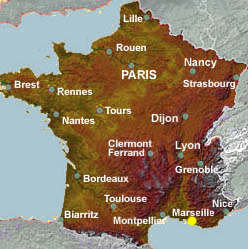
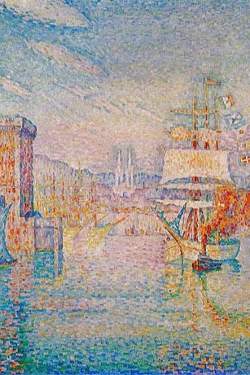
Copyright © About-France.com 2003 - 2025 Plan of Marseille from an open-source original from openstreetmap.org.
The old port seen from Fort Saint Jean
Where
to stay in Marseilles
Grand Hotel Beauvau vieux Port - A four-star boutique hotel located on the Old Port, close to the metro and bus. Rooms with view over the harbour. Private parking.
Hotel Radisson Blu Vieux Port Between the Abbaye Saint Victor and the Fort Saint Nicolas, on the south side of the Old Port. Outdoor swimming pool. Public car park close by.(daily charge).
Recommended ...
Hotel Escale Oceania Vieux Port Located at the foot of the Canebière, 100 metres from the Old Port. Couldn't be more central. Bus, metro and leisure boats right close by. Public car park nearby.
Best-Western - Mucem - Vieux Port - In the old city close to the cathedral, the quayside, the Vieux . Port Good central location at reasonable prices.
Lots more three-star hotels
Click here for a large selection of three star hotels in Marseille
Two star hotels
Recommended ...
Hotel Hermes - Small two-star hotel right on the Old Port, some with view. Roof terrace with chairs and tables and harbour view.
Hotel Ibis Budget Vieux Port - 500 metres from the Old Port, a modern budget hotel housed in a 16th century sea captain's residence. Parking on site.
More two-star hotels
Click here for a good list of two star budget hotels in Marseilles.
2. Apartments - gites
Follow this link for short-stay apartments and click here for classic city gites
A choice of carefully selected hotels and apartments in Marseilles.
These hotels are conveniently sited in or near the Old Port area, and all have good write-ups. Click links for details and to book at best ratesFive
stars ★★★★★
Hotel
Intercontinental Hotel Dieu Five star luxury in a 17th
century building 350 metres from the Old Port. Parking on site (daily
charge). Four
stars ★★★★
Grand Hotel Beauvau vieux Port - A four-star boutique hotel located on the Old Port, close to the metro and bus. Rooms with view over the harbour. Private parking.
Hotel Radisson Blu Vieux Port Between the Abbaye Saint Victor and the Fort Saint Nicolas, on the south side of the Old Port. Outdoor swimming pool. Public car park close by.(daily charge).
Three
stars ★★★
Recommended ...
Hotel Escale Oceania Vieux Port Located at the foot of the Canebière, 100 metres from the Old Port. Couldn't be more central. Bus, metro and leisure boats right close by. Public car park nearby.
Best-Western - Mucem - Vieux Port - In the old city close to the cathedral, the quayside, the Vieux . Port Good central location at reasonable prices.
Lots more three-star hotels
Click here for a large selection of three star hotels in Marseille
Two star hotels
Recommended ...
Hotel Hermes - Small two-star hotel right on the Old Port, some with view. Roof terrace with chairs and tables and harbour view.
Hotel Ibis Budget Vieux Port - 500 metres from the Old Port, a modern budget hotel housed in a 16th century sea captain's residence. Parking on site.
More two-star hotels
Click here for a good list of two star budget hotels in Marseilles.
2. Apartments - gites
Follow this link for short-stay apartments and click here for classic city gites
An
independent website, About-France.com is an affiliate partner of
certain travel service websites,
and may receive a small commission on sales generated after users click
through to a partner site.
Key tourist information for Marseilles :
Access - getting to Marseilles
By road : Marseilles is 9 hours drive from Calais, 7 hours from Paris, and 5h from Barcelona.
By train: direct TGV services from Paris (3 hours 45), Lille (5 hours) Lyon (1h 45) Nice and Strasbourg. Regular International train services to Italy, Belgium and Spain. For timetables and online tickets, see Trainline.com .
Marseilles train stations :
Marseille Saint Charles.The Marseilles city pass :
The Marseilles City Pass provides free entry to museums, a boat trip to the Chateau d'If, a trip on the little tourist train, free use of Marseille city transport (bus and metro) and discounts on other attractions. It can be purchased online from the Tourist office for 1, 2 or 3 days. Adult one day rate 24 € (2016) For more information and to buy online click here.
Location
:
Region: Provence Alpes
Côte d'AzurNearby cities: Toulon, Avignon, Nimes, Montpellier.
Urban area Population 1.6 million
Main sites: The area round the Old Port, the Chateau d'If, the Canebière, the Mucem and Cantini museums, la Major cathedral and Notre Dame de la Garde.
Nearby attractions: The Calanques National Park, The Camargue, the Rhone Delta and its historic sites, Aix en Provence.
Accommodation: See below
Marseilles or Marseille ?
Just like the city of Lyons, Marseilles is traditionally spelt with an "s" at the end in English, but without the "s" in French.

The
Old Port in the early 20th century. From a painting by Paul Signac in
the Cantini Museum
Click here for
low-cost car hire in France
low-cost car hire in France
Copyright © About-France.com 2003 - 2025 Plan of Marseille from an open-source original from openstreetmap.org.

